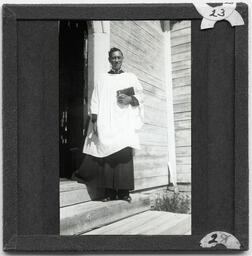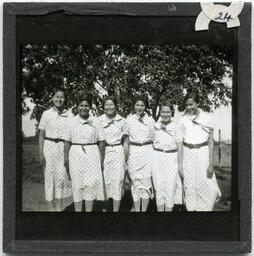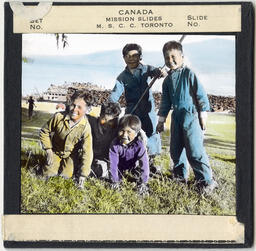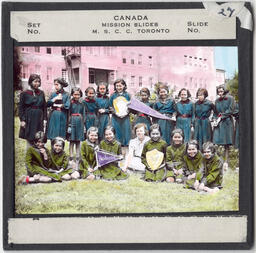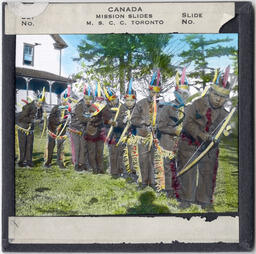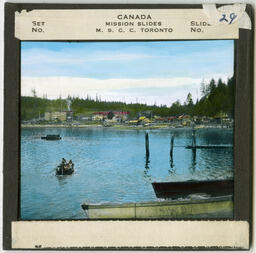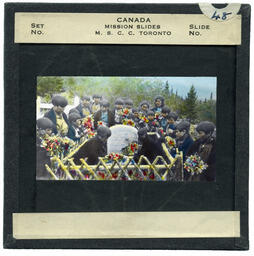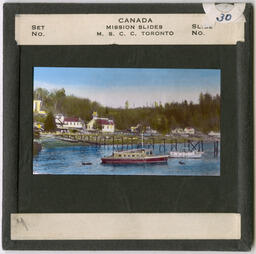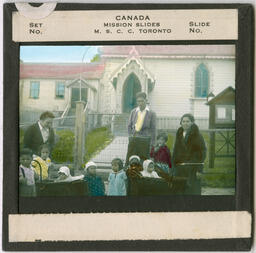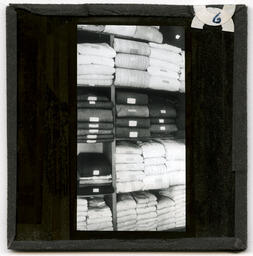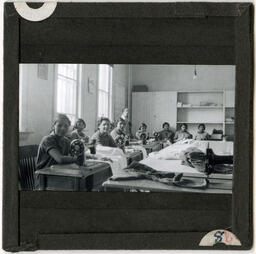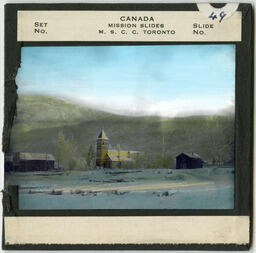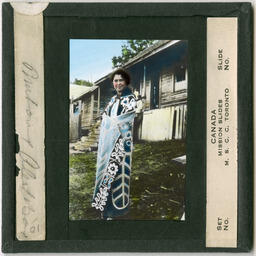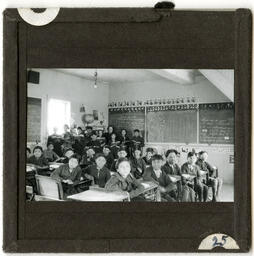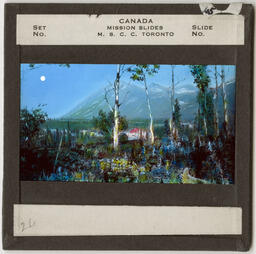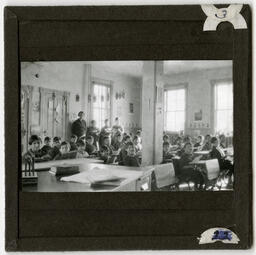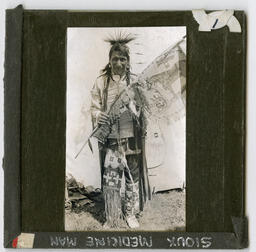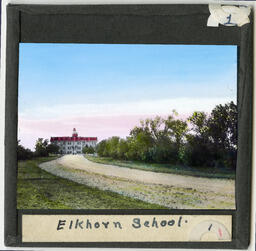Missionary Society of the Church of England in Canada
Related Works
Content type
Image
Description / Synopsis
Minister by the entrance of a church. Based on the original order of the collection, photograph might have been taken at Elkhorn (Washakada) Residential School. The Elkhorn Residential School started as the Washakada Home for Girls and the Kasota Home for Boys were established in the village of Elkhorn, MB in 1888. Following a fire, the school was rebuilt outside the town in 1895. Ongoing financial problems led to a government takeover of the school. It was closed in 1918 but reopened in 1923, under the administration of the Anglican Church’s Missionary Society. Many students came from northern Manitoba. The leaders of The Pas Indian Band made a number of complaints about the conditions at the school, which was eventually closed in 1949. (National Centre for Truth and Reconciliation)
Origin Information
Content type
Image
Description / Synopsis
Six teenage girls dressed up with uniforms in front of a tree. Based on the original order of the collection, photograph might have been taken at Elkhorn (Washakada) Residential School. The Elkhorn Residential School started as the Washakada Home for Girls and the Kasota Home for Boys were established in the village of Elkhorn, MB in 1888. Following a fire, the school was rebuilt outside the town in 1895. Ongoing financial problems led to a government takeover of the school. It was closed in 1918 but reopened in 1923, under the administration of the Anglican Church’s Missionary Society. Many students came from northern Manitoba. The leaders of The Pas Indian Band made a number of complaints about the conditions at the school, which was eventually closed in 1949. (National Centre for Truth and Reconciliation)
Origin Information
Content type
Image
Description / Synopsis
Waterfront view of Alert Bay with Saint Michael's Residential School. According to annotations, slide is set number 3063.
Origin Information
Content type
Image
Description / Synopsis
Five children in playing attitude with the sea in the background. Based on the original order of the collection, photograph might have been taken in Alert Bay and the children might have been students at St. Michael's Residential School. The Anglican Church established a day school at its mission in Alert Bay, British Columbia in 1878. It opened a small boarding school there in 1882 and an industrial school in 1894. In 1929, a new building was constructed. The school was known for the arts and crafts produced by the students and the two large totem poles in front of the school building. In 1947, two-dozen children ran away from the school. The subsequent investigation into conditions at the school led to the resignation of both the principal and the vice-principal. By 1969, when the federal government assumed administration of the school, all residents were attending local schools. The residence closed in 1974. (National Centre for Truth and Reconciliation)
Origin Information
Content type
Image
Description / Synopsis
Twenty children and one adult holding house pennants with the names "Robins" and "Ravens" and shields in front of a building. Item is a duplicated of item no. S7-60, fonds 008 Missionary Society of the Church of England in Canada (MSCC) fonds, from the Anglican Church of Canada General Synod Archives. According to description from the Anglican Church of Canada General Synod Archives, Ravens (senior girls) and Robins (junior girls) pose with the shields won in intramural competition. The Anglican Church established a day school at its mission in Alert Bay, British Columbia in 1878. It opened a small boarding school there in 1882 and an industrial school in 1894. In 1929, a new building was constructed. The school was known for the arts and crafts produced by the students and the two large totem poles in front of the school building. In 1947, two-dozen children ran away from the school. The subsequent investigation into conditions at the school led to the resignation of both the principal and the vice-principal. By 1969, when the federal government assumed administration of the school, all residents were attending local schools. The residence closed in 1974. (National Centre for Truth and Reconciliation)
Origin Information
Content type
Image
Description / Synopsis
Nine children in costumes in front of a building. Based on the original order of the collection, photograph might have been taken in Alert Bay.
Origin Information
Content type
Image
Description / Synopsis
Waterfront view of Alert Bay with Christ Church Anglican church in the background and two boats in the foreground.
Origin Information
Content type
Image
Description / Synopsis
Nineteen people (adults and children) taking flowers to a grave. Based on the rest of the collection and general aspect, photograph might have been taken in Carcross, Yukon and the grave might be of Bishop Bompas, first Bishop of Selkirk (later Yukon) who died in 1906. Bishop Bompas founded the ChoutlaResidential School. Item is similar to item no. 620, fonds 008 Missionary Society of the Church of England in Canada (MSCC) fonds, from the Anglican Church of Canada General Synod Archives.
Origin Information
Content type
Image
Description / Synopsis
Waterfront view of Alert Bay with Christ Church Anglican church in the background and two boats in the foreground.
Origin Information
Content type
Image
Description / Synopsis
Eight children and three adults in front of a church. Based on the original order of the collection, photograph might have been taken in Alert Bay and the church might be Christ Church, Anglican church.
Origin Information
Content type
Image
Description / Synopsis
Laundry room. Based on the original order of the collection, photograph might have been taken at Elkhorn Residential School. The Elkhorn Residential School started as the Washakada Home for Girls and the Kasota Home for Boys were established in the village of Elkhorn, MB in 1888. Following a fire, the school was rebuilt outside the town in 1895. Ongoing financial problems led to a government takeover of the school. It was closed in 1918 but reopened in 1923, under the administration of the Anglican Church’s Missionary Society. Many students came from northern Manitoba. The leaders of The Pas Indian Band made a number of complaints about the conditions at the school, which was eventually closed in 1949. (National Centre for Truth and Reconciliation)
Origin Information
Content type
Image
Description / Synopsis
Linen closet. Based on the original order of the collection, photograph might have been taken at Elkhorn Residential School. The Elkhorn Residential School started as the Washakada Home for Girls and the Kasota Home for Boys were established in the village of Elkhorn, MB in 1888. Following a fire, the school was rebuilt outside the town in 1895. Ongoing financial problems led to a government takeover of the school. It was closed in 1918 but reopened in 1923, under the administration of the Anglican Church’s Missionary Society. Many students came from northern Manitoba. The leaders of The Pas Indian Band made a number of complaints about the conditions at the school, which was eventually closed in 1949. (National Centre for Truth and Reconciliation)
Origin Information
Content type
Image
Description / Synopsis
Group of children in a classroom. The lesson seems to be on sewing with nine older children and one teacher or supervisor. Based on the original order of the collection, photograph might have been taken at Elkhorn Residential School. The Elkhorn Residential School started as the Washakada Home for Girls and the Kasota Home for Boys were established in the village of Elkhorn, MB in 1888. Following a fire, the school was rebuilt outside the town in 1895. Ongoing financial problems led to a government takeover of the school. It was closed in 1918 but reopened in 1923, under the administration of the Anglican Church’s Missionary Society. Many students came from northern Manitoba. The leaders of The Pas Indian Band made a number of complaints about the conditions at the school, which was eventually closed in 1949. (National Centre for Truth and Reconciliation)
Origin Information
Content type
Image
Description / Synopsis
Winter village with a church.
Origin Information
Content type
Image
Description / Synopsis
Woman in a shawl. According to annotations, photograph was taken in Alert Bay.
Origin Information
Content type
Image
Description / Synopsis
Group of children in a classroom. Twenty six children are visible, ten of them standing, the rest sitting down. The blackboard has what it seems to be linguistic and mathematical lessons written on it. Based on the original order of the collection, photograph might have been taken at Elkhorn (Washakada) Residential School. The Elkhorn Residential School started as the Washakada Home for Girls and the Kasota Home for Boys were established in the village of Elkhorn, MB in 1888. Following a fire, the school was rebuilt outside the town in 1895. Ongoing financial problems led to a government takeover of the school. It was closed in 1918 but reopened in 1923, under the administration of the Anglican Church’s Missionary Society. Many students came from northern Manitoba. The leaders of The Pas Indian Band made a number of complaints about the conditions at the school, which was eventually closed in 1949. (National Centre for Truth and Reconciliation)
Origin Information
Content type
Image
Description / Synopsis
Landscape with the Choutla Residential School, Carcross, Yukon. Item is a duplicate of item no. 875, fonds 008 Missionary Society of the Church of England in Canada (MSCC) fonds, from the Anglican Church of Canada General Synod Archives. In 1903 students from the school at Forty Mile, Yukon, were moved to a small school in Carcross. In 1911 the federal government built the Choutla school. The school had a reputation for poor health, harsh discipline, poor food, and unpleasant living quarters. In the 1940s, the principal admitted to strapping students so severely that they had to be held down. The school burned down in 1939 and was rebuilt in 1944. A new school was built in 1953. It closed in 1969. (National Centre for Truth and Reconciliation)
Origin Information
Content type
Image
Description / Synopsis
Group of children in a classroom. Twenty nine children are visible, four of them standing, the rest sitting down. Based on the original order of the collection, photograph might have been taken at Elkhorn (Washakada) Residential School. The Elkhorn Residential School started as the Washakada Home for Girls and the Kasota Home for Boys were established in the village of Elkhorn, MB in 1888. Following a fire, the school was rebuilt outside the town in 1895. Ongoing financial problems led to a government takeover of the school. It was closed in 1918 but reopened in 1923, under the administration of the Anglican Church’s Missionary Society. Many students came from northern Manitoba. The leaders of The Pas Indian Band made a number of complaints about the conditions at the school, which was eventually closed in 1949. (National Centre for Truth and Reconciliation)
Origin Information
Content type
Image
Description / Synopsis
Indigenous man dressed in ceremonial clothing.
Origin Information
Content type
Image
Description / Synopsis
Building from afar. According to annotation, building was Elkhorn (Washakada) Residential School. The Elkhorn Residential School started as the Washakada Home for Girls and the Kasota Home for Boys were established in the village of Elkhorn, MB in 1888. Following a fire, the school was rebuilt outside the town in 1895. Ongoing financial problems led to a government takeover of the school. It was closed in 1918 but reopened in 1923, under the administration of the Anglican Church’s Missionary Society. Many students came from northern Manitoba. The leaders of The Pas Indian Band made a number of complaints about the conditions at the school, which was eventually closed in 1949. (National Centre for Truth and Reconciliation)
Origin Information

